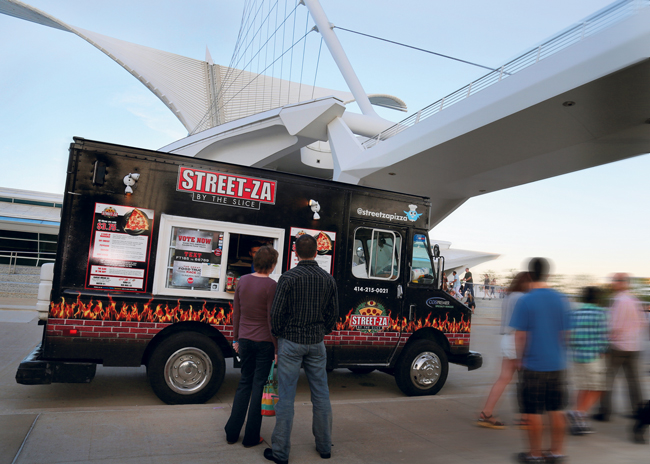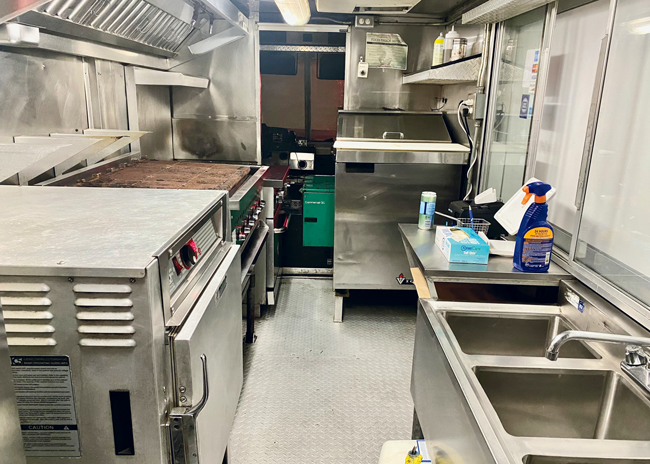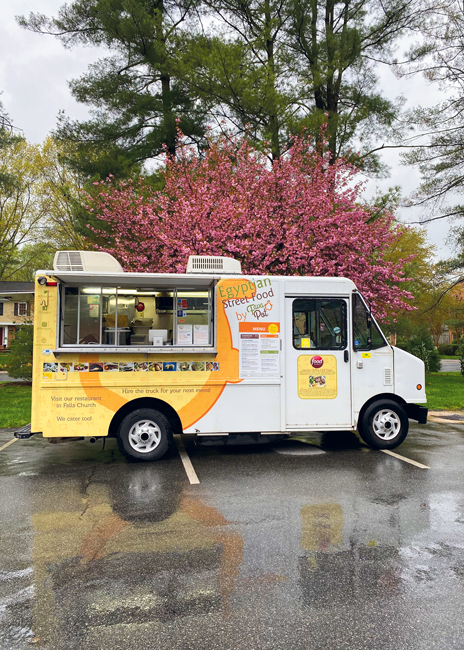Food trucks have become a popular option for those wanting to test a concept before making a bigger investment in a brick-and-mortar operation. And the benefits of being mobile are not just financial. Operators can try out different locations first. Menu experimentation is easier. Labor requirements are minimal, and supply issues can be more easily addressed.
“Truck concepts have to be very efficient to operate less expensively since there is minimal access to power,” says Darren Tristano, CEO of Chicago-based FoodserviceResults.
A functional design starts from the outside, with the truck’s graphics portraying the concept, visible menu boards or signs detailing what’s available, and a large window for orders.
A Unique Business Model
The Milwaukee-based Street-Za food truck was created in 2009 by Scott Baitinger and Steve Mai. This concept’s pizza combinations are mostly “crowd-sauced,” with suggestions for new pizzas originating from Street-Za’s social media audience. Its more than 350 seasonal menu items change daily and rely on the 24-foot-long truck’s refrigerated pizza prep table, pizza oven and hot box.
“Our entire menu is dedicated to Milwaukee neighborhoods,” Baitinger says. “When we were at [Major League Baseball’s] Miller Park, we created a pizza paying homage to the Brewers’ opposing team, the Pittsburgh Pirates, with salami, provolone, ham and fries. We also offer one wacky pizza of the day.”
 Staff prepare Street-Za’s more than 350 seasonal menu items, which change daily, using the 24-foot-long truck’s refrigerated pizza prep table, pizza oven and hot box. When the truck was first established, 90% of sales were off the street, and 10% were from catering. Now, according to Baitinger, the percentages have flipped due to word of mouth. “There are two business models — a slow dime where the truck is parked in the same spot all day, or a quick nickel, where the truck is positioned at a busy event or business for three to four hours,” he explains.
Staff prepare Street-Za’s more than 350 seasonal menu items, which change daily, using the 24-foot-long truck’s refrigerated pizza prep table, pizza oven and hot box. When the truck was first established, 90% of sales were off the street, and 10% were from catering. Now, according to Baitinger, the percentages have flipped due to word of mouth. “There are two business models — a slow dime where the truck is parked in the same spot all day, or a quick nickel, where the truck is positioned at a busy event or business for three to four hours,” he explains.
Regardless of the model, one of the biggest challenges with food trucks is speed of service, since most operate in high-volume environments.
Michelle Minori is associate director of culinary at San Francisco’s The Culinary Edge, a restaurant and hospitality consulting firm. Her background includes a stint as a research and development chef for food truck company Off the Grid, also in San Francisco. In addition to speed-of-service issues, another concern comes by way of food in transit on the truck, she adds. “Design is a huge part of it — some of this category’s challenges are you can’t run refrigeration units when trucks are in motion, and food doesn’t bode well in regular foodservice containers while being transported,” Minori explains. “We’d use vacuum packaging, which is not sustainable.”
Another issue is equipment performance, Minori adds, which can be compromised in a smaller space that has temperature variances. She notes that traditional gas ovens can pose a big fire risk if not lit correctly in trucks, and heating food to temperature is more challenging in these spaces.
“We’d use burners to cook, while heating something else in the oven, and the oven always took longer to heat up,” Minori says. “So, we leaned into speed ovens. We could handle up to 400 covers in 2½ hours but learned it’s best not to have too many items that are a la minute.”
Marti Lieberman, owner/founder of Philadelphia’s Mac Mart Cart, which ran from 2013 to 2019, transitioned her business to a single brick-and-mortar operation due to truck staffing challenges.
“The problem was my sister and I were the only ones who knew how to drive the truck,” she says.
Scaling equipment to fit is another consideration. Fava Pot, a Falls Church, Va.-based food truck concept that began operation in 2013, offers made-to-order Egyptian and Israeli food. Its 18-foot-long vehicle houses smaller-sized equipment, including a four-burner stove, 36-inch grill, hand sink, refrigerator and refrigerated prep table. All units are flush and anchored to the floor.
“Only the bread for our sandwiches is made in advance at our restaurant,” says Fava Pot owner Dina Daniel. “Everything else is made in the truck.”
Like with traditional restaurants, local regulations will vary, which impacts truck design. However, this is made more complicated when trucks operate in different jurisdictions. Although the Mac Mart Cart wasn’t required to have a three-bay sink when operating in Pennsylvania, it regularly serviced areas in New Jersey, where this equipment was required.
For this reason and a host of others, Eddie Fahmy, CEO at A2Z Restaurant Consulting, based in Great Neck, N.Y., contends that food trucks are more complicated than brick-and-mortar restaurants. “You’re not just putting everything you need for immediate use in the truck, but also need a backup area,” Fahmy explains.
For a recent Amazon-sponsored food truck promoting its “Marvelous Mrs. Maisel” series, a refrigerated truck that was fully stocked with backup product was parked on a street in New York City. “Those who operate food trucks on a daily basis have to take into consideration projected sales for the day and make sure there is enough refrigeration on the truck to carry product, otherwise they need to facilitate a backup plan,” Fahmy says. “A refrigerated backup truck can be used if it fits the budget, or the alternative is to have a remote facility for storage.”
 The interior of Fava Pot's food truck includes smaller-sized equipment, including a 4-burner stove, 36-inch grill and refrigerated prep table.
The interior of Fava Pot's food truck includes smaller-sized equipment, including a 4-burner stove, 36-inch grill and refrigerated prep table.
Looking at Logistics
Space is more precious when it is limited, so food trucks need to be designed for maximum efficiency. This can be challenging, as the typical truck is just 7 feet wide and ranges from 10- to 26-feet long. “The ability to accomplish tasks in a smaller area without staff overlapping is key,” Baitinger says. “Even in larger food trucks, if people have to move in a linear fashion, bypassing becomes more difficult. It has to be one person at a time in the lane due to the truck’s width.”
Not only do the wheel wells need to be accounted for and worked around, but it’s also important to brace equipment so it’s attached to the truck as securely as possible.
“In our case, everything is bracketed and mounted to the truck,” Baitinger says. “Even something as simple as the pizza oven decks fits on top of brackets we added so it won’t bounce. The more you can lock things down, the longer the equipment lasts.”
He adds that during colder winter months, it’s best to not leave refrigeration running within the truck when it’s not active. “We learned colder outdoor temperatures confuse the refrigeration equipment, and it’s better for the compressors to keep units turned off,” Baitinger says. “Most trucks have aluminum bodies, so if it’s 0 degrees outside, it’s 0 degrees in the truck.”
Although a galley-style kitchen is commonplace in brick-and-mortar restaurants, this layout works very differently when it’s within a narrower food truck. “The ability to work in spaces is very different in a truck,” Baitinger says. “In a traditional restaurant where you have a 4-foot-by-4-foot cube, it’s 2 feet by 2 feet in a truck set up in a linear fashion.”
In addition to space limitations, temperature control within the truck is a concern. “Especially with cooking units, the heat output is so much less with electricity compared to gas,” Minori says. “There were days we had to shut down service because it was too hot for people to work in the truck.”
Minori says back doors with screens help with air circulation; air-conditioned trucks are available, but rare. Equipment proximity also is a consideration, she adds: The cold area needs to be separated from the hot area, with hot equipment segregated from the ordering window.
As with any commercial kitchen, for efficient flow, equipment also should be strategically placed according to the menu. Unfortunately, it can be difficult to picture the scenario prior to a truck being operational.
“Every food truck will have its own unique setup, since each menu is different,” Fahmy says.
It is an expensive mistake to realize, for example, the steam table needs to be on the other side of the grill due to the time it takes to access it. It’s important to think logistically. The consensus from food truck operators: It’s best to test drive the menu either in an existing truck or with a mockup of the design before locking down the layout. This gives the operator an advantage before making the equipment investment.
“Putting the refrigerator, grill and deep fryer in that order works best, since most of the time what’s coming out of the refrigerator is going into the fryer and you’re not crossing paths,” Fahmy explains. “Operators also have to take into consideration that certain pieces of equipment have different side hinges. Make sure the refrigerator’s opening is nearest to the equipment you’re going to use.”
In food trucks, it can be more difficult incorporating state-of-the-art technology, which is not always preferable due to the impact inclement weather can have on electronics. “Equipment is typically low tech due to the tight space [and temperature variances], although some food trucks utilize high-tech filtration fryers,” Minori says.
In addition to incorporating appropriate equipment that fits, maximizing space relies on thinking outside the box and getting creative. “We had a truck designed with a long strip of narrow space by the ordering window that had drop-down wells for holding hot and cold food,” Minori says. “This created extra counter space as well.”
Off-site kitchen space or commissaries are often a necessity, as this is where much of the prep takes place and where many operators store their inventory. “Before we obtained an off-site kitchen, we used a shared commissary for storage,” Daniel says. “All our items are grilled within about two hours of serving and then stored in the truck’s warmer.”
Street-Za uses a shared, 2,500-square-foot commissary kitchen to prepare its ingredients ahead as well as to prepare and sheet its dough. Staff then assemble and cook the pizzas on the truck. “Ours is a moderate complexity food truck,” Baitinger says. “We use a commissary for all our storage and most prep work. It includes walk-in coolers and freezers, a 16-burner convection oven and a 30-quart mixer.”
Do’s and Don’ts
Naturally, running a food truck differs from operating a brick-and-mortar restaurant in several ways. “All shelves need ledges so items don’t fall off during transport,” Daniel says. “And propane used for cooking cannot be exposed.”
 Fava Pot food truck prepares its Egyptian and Israeli offerings in an 18-foot truck.Fava Pot’s generator sits in the passenger area of the truck, where a seat was taken out to accommodate it.
Fava Pot food truck prepares its Egyptian and Israeli offerings in an 18-foot truck.Fava Pot’s generator sits in the passenger area of the truck, where a seat was taken out to accommodate it.
Like in many commercial kitchens, storage space is at a premium. But in food trucks, it’s necessary to use all space creatively. “We made storage happen under equipment, over equipment, on walls using magnets and hooks,” Lieberman says. “Plus, everything needs to be put away during transit.”
All spaces should be put to proper use. Tall reach-ins are ideal for narrow footprints but can create wasted space if not fully utilized. The top of undercounter refrigeration can double as counter space during service hours.
Food truck equipment should be able to withstand the rigors not only of high-volume use but also a harsh environment that includes wide temperature fluctuations and bumpy trips. Power needs, whether electric or propane, should also be assessed.
“The first pizza oven we bought never made it on the truck; it was electric, and we couldn’t pull enough power from any generator to make it work,” Baitinger says. “We didn’t want to use a large generator due to the excessive noise and emissions, so we switched to a propane oven.”
Baitinger modified the deck oven, adding a third deck and adjusted the propane output to accommodate it. “It’s an interesting dilemma that food trucks with extreme climate changes deal with,” he says. “Foodservice equipment is not meant to bounce around or be in extreme temperatures.” He says although pizza ovens are typically foolproof boxes with a heat source, decks can crack when bouncing around on a truck.
To help circumvent these issues, Minori says all equipment needs to be properly balanced on chassis. “We don’t see much heavy equipment on food trucks, as there can’t be too much weight on one side versus another,” she says.
With functional food truck design, it’s all about menu engineering. “Engineer the menu so you know which station everything is coming off of,” Fahmy recommends. “When setting up a [fire protection] system, it’s costly — you can’t just move equipment around once it’s situated because the piping is designated for specific pieces of equipment. There are the same considerations for under the ventilation hood for a food truck as with a brick-and-mortar restaurant.”



